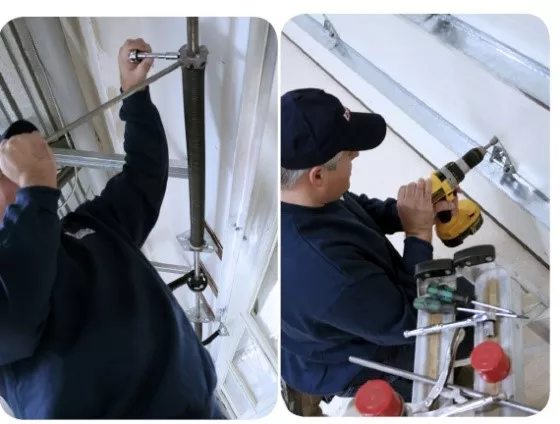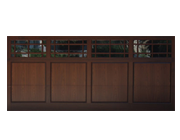
Does the idea of spring break conjure up images of fun in the sun at the beach? That’s natural. However, not all spring breaks are filled with sand, surf, and fun. Some can actually be detrimental, stressful, and frustrating. We’re talking about the springs on your garage door.
If you hear a loud POP from the garage, chances are good that one of them has given up the ghost. You might not even notice the sound, but the next time you open your garage door you might find that your lifting spring is now in two pieces.
What causes garage door springs to break? What can you do to prevent it? Who do you call to get you out of this mess? In this post, we’ll walk you through the answers to these questions and many others.
The Importance of Your Garage Door Spring System
Prior to jumping into how your garage door spring became damaged, it’s important to establish the role the spring system plays in your garage in the first place. Your door has one of two types of spring system:
Torsion – If you look over your garage door and see a steel tube, you have a torsion spring system. The entire weight of the door is transferred to a steel anchor plate over the door. Don’t see a tube or plate? You might have limited headroom over the door. In this instance, the plate may be installed at the end of horizontal tracks.
Extension – If your garage door has dual springs located on either side of the horizontal tracks it rolls on, then you have an extension spring system. In this setup, the springs expand and contract as the door raises and lowers. Note that any extension spring system should also have safety cables installed. These are important for protecting against additional damage should a spring break.
In both types of system, the spring works as a counterweight to the door, allowing you to open and close the door easily. It can dramatically reduce the actual weight of the door – a 9 x 7 foot door might really weigh in around 135 pounds (or 61 kilos), but the springs allow you to raise and lower it with just one hand. A correctly balanced garage door will only feel like it weighs between 8 and 10 pounds.
Your electric garage door opener is more than up to the task of raising that much weight. Most of them on the market can easily lift around 200 pounds. However, remember that the opener can push down with just as much force as it uses to lift the door, meaning that anything caught between the door and the ground can be seriously damaged.
Why Do Springs Break?
There are quite a few reasons why a garage door spring might break. Some of the most common are discussed below:
- Simple Wear and Tear – Perhaps the single most common reason for a spring to break is normal wear and tear. Most springs are rated with a 10,000‑cycle lifespan. That means you can open and close it 10,000 times, and it should last about 7 years. If you need to use your garage door more than once or twice per day, you’ll need to look for a system that can handle 20 or 25,000 cycles.
- Defective – Another possibility here is a defect in the materials or workmanship. The most common defect with extension springs is a broken end loop. With torsion springs, the most common defect is poor galvanization, which allows rust to set in early.
- Poor Calibration – If your garage door uses two springs with different capacities, the weaker of the two will be subject to greater stress and will eventually break. Make sure that your door is correctly calibrated with two springs of equal capacity (e.g. each can support 100 pounds, rather than one being rated for 100 pounds and the other being rated for 150 pounds).
- Temperature and Humidity – Garage door springs can fail due to cold and damp conditions. If the environment is too humid, even good quality galvanization will not protect against rust. If the temperature gets too cold, it can cause the springs to break, as well.
- Maintenance – As the homeowner, it’s your responsibility to maintain your entire garage door system. Garaga recommends maintenance twice per year – spring and fall.
How to Increase Your Garage Spring Lifespan
Want to ensure that your garage door springs stand the test of time and hard use? Just follow these basic tips.
Get yourself a decent quality lubricant. We recommend 10W30 engine oil. Apply this to the springs twice per year with a clean, dry rag. Just make sure that you don’t use WD‑40, as this is actually a degreaser, not a lubricant.
When you apply the oil, use a light touch. A little bit is all you need. When you’re done, make sure to wipe off any excess, or it will drip onto the garage floor. Not only will this help keep your springs in great condition, but it will also help to silence any unusual noise you might have noticed during operation.
You can find all the garage door lubricants that you’ll need with your local Garaga dealer.
Get the Professionals on Your Side
Not sure you can handle your garage door maintenance? Worried that your springs are already deteriorating? Has one of your garage door springs already broken? We can help. We offer a complete garage door tune‑up program designed to ensure all the components of your system stay in good condition.
You can contact us! We will be happy to go over your options, explain our services, answer questions, and more. You can also drop by the showroom in person if you want, or you can get an email quotation if that’s your preferred route.
If you are in the market for a new garage door, then we would recommend you check out our Design Centre. You’ll find a range of garage door designs and styles, as well as the ability to try them out on a photo of your home. To see what we have accomplished for other customers, you can check out our image gallery.








Add new comment